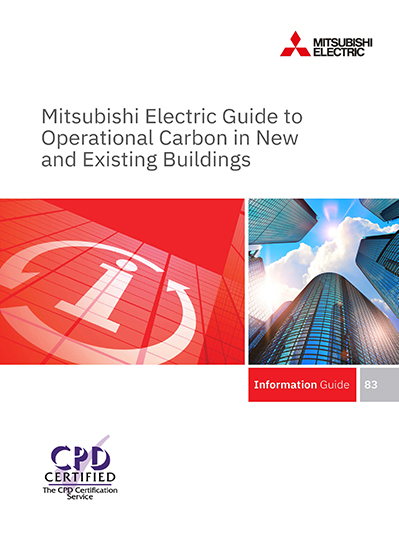12 March 2024
|

Graham Temple, Marketing Manager at Mitsubishi Electric, explains the importance of reducing the carbon impact of building performance.
The UK has set a target to reach Net Zero carbon emissions by 2050 and in some ways we are well on the way towards achieving this objective; in others, the country still has some way to go. The Climate Change Committee (CCC) reported in June that UK emissions have been falling steadily over the last three decades, and we are ‘likely’ to have met our most recent carbon budget, which ran from 2018 to 2022.
However, the CCC also warned that the UK cannot rely on past success to carry it into a low-carbon future, and carbon reduction targets for all sectors will become more challenging in the next carbon budget.
With that, there must be a focus on reducing the carbon impact of building performance in particular. As part of this, one of the big areas of focus for buildings must be reducing the operational carbon (the carbon produced during a building’s use phase). Some of these emissions may be direct - such as burning fossil fuels such as gas or oil on-site for heating and hot water – while others might be indirect operational emissions, created when electricity used in the building is generated from fossil fuels.
The UK Green Building Council states that 19% of the UK’s carbon footprint is from operational emissions produced from energy used to heat, cool and power buildings – so understanding the drivers and strategies to reduce it is crucial.
The drivers of operational carbon reduction
There are a variety of standards and pieces of legislation being put in place to keep building emissions – including operational carbon emissions – down.
For example, Energy Performance Certificates (EPCs) are central to several government policies around building performance, particularly energy efficiency. The prime example is Minimum Energy Efficiency Standards (MEES), which the government is using to drive higher energy efficiency in new and existing buildings. If a commercial building does not achieve an EPC rating of B by 2030, it cannot be leased or sold, impacting its asset value.
Given that the current minimum is E, many commercial buildings face the challenge of significant upgrades to meet the new standard. In fact, the property industry estimated that in 2021, 60% of existing stock would not achieve a B rating and that landlords would have to invest in efficiency refurbishment at double the usual rate over the next seven years.
There is also work being done to develop specific definitions and targets for ‘Net-Zero’ buildings, and some businesses in the construction, property and installation sectors are adopting voluntary standards and more accurate measures of building energy use. They are also examining the buildings they own or occupy in terms of corporate sustainability and ESG strategies, and are finding ways to estimate operating costs as well as carbon emissions.
All of this means that there must be a greater focus on measuring and then reducing operational carbon to help keep overall emissions down, and ensure increasingly stringent standards are being met – and that buildings don’t become ‘stranded assets’ in the near future.
Strategies to cut operational carbon emissions
The UK Green Building Council defines a Net Zero operational energy building as: “When the amount of carbon emissions associated with the building’s operational energy on an annual basis is zero or negative.”
Building owners looking to achieve this must start with looking at their HVAC systems, as they are significant energy users. Whether a building owner is targeting a higher EPC rating or simply wants to improve the energy performance of their building, a systems approach is key to success.
Four areas to focus on include:
1. Decarbonise heating and hot water
Targeting operational Net-Zero means removing the use of fossil fuels on-site. Buildings are increasingly moving away from the use of any natural gas or oil for heating and hot water and switching to an ‘all electric’ approach. Heat pumps are one of the most widely used alternatives to the gas or oil boiler, and they provide energy efficient electric heating, as well as meeting domestic hot water requirements. Modern commercial heat pumps can now deliver water temperatures up to 90oC, so can be applied in buildings with significant hot water demands, for example, from showers and gyms.
2. Make use of ‘waste’ heat energy
Modern HVAC equipment is energy efficient, but performance can be optimised further. One way to do this is through heat recovery, where ‘waste’ heat is used as an energy source, taking heat energy ejected from one part of a building and applying it in another.
For example, this strategy can be used through mechanical ventilation with heat recovery (MVHR). Heat energy from air expelled by the ventilation system is transferred to incoming outdoor air before it enters the occupied space. This reduces the amount of heating required for incoming air, saving energy.
On a larger scale, the heat recovery principle is also used in ambient heat loops. These can be particularly useful for mixed-use developments where heat extracted from office or retail cooling systems is transferred to on-site residences such as apartments using heat pump technology.
3. Use controls to monitor and manage energy use
Building controls are critical in helping building managers monitor and manage energy use – especially given the growing requirement for data collection on building performance. In addition, the ability to spot trends gives facilities and energy management teams the insights to take action where energy is potentially wasted.
4. Specify HVAC equipment to achieve carbon objectives
One of the most challenging aspects of the focus on the carbon impact of buildings is how it may affect the specification process. For example, highly energy efficient equipment may have a higher embodied carbon footprint than an alternative which uses more energy in the long term, affecting the building’s operational carbon.
Some important questions for specifiers include, at what point does the equipment’s operational efficiency outweigh higher embodied carbon? Or how long does a high-efficiency product with high embodied carbon have to operate before its whole life carbon balances against a lower-efficiency product with lower embodied carbon?
Closing thoughts
As building designers, owners and managers look to create low carbon buildings for the future, operational carbon is a key area to consider. The UK is facing rising temperatures and more stringent carbon emission legislation, and therefore it will be vital to consider of how our existing building stock, constructed for a cooler climate, will manage higher temperatures in the next decade.
Fundamentally, we can combat these challenges by taking control of operational carbon. Considering the HVAC equipment used in buildings, as well as being able to closely monitor energy use and even make use of ‘waste’ heat will help the UK to meet carbon targets while tackling a changing climate. The work should start now because there are so many factors to consider, and buildings that adapt and become more sustainable will be the ones that retain their value in the years to come.
- Mitsubishi Electric has released a CPD guide on this topic, available to download here.









